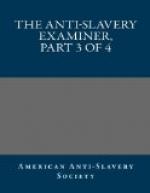The following is from the “Charleston (S.C.) Patriot,” Oct. 18.
“Loss of Property!—Since I have been here, (Rice Hope, N. Santee,) I have seen much misery, and much of human suffering. The loss of PROPERTY has been immense, not only on South Santee, but also on this river. Mr. Shoolbred has lost, (according to the statement of the physician,) forty-six negroes—the majority lost being the primest hands he had—bricklayers, carpenters, blacksmiths and Coopers. Mr. Wm. Mazyck has lost 35 negroes. Col. Thomas Pinkney, in the neighborhood of 40, and many other planters, 10 to 20 on each plantation. Mrs. Elias Harry, adjoining the plantation of Mr. Lucas, has lost up to date, 32 negroes—the best part of her primest negroes on her plantation.”
From the “Natchez (Miss.) Daily Free Trader,” Feb. 12, 1838.
“Found.—A NEGRO’S HEAD WAS PICKED UP ON THE RAIL-ROAD YESTERDAY, WHICH THE OWNER CAN HAVE BY CALLING AT THIS OFFICE AND PAYING FOR THE ADVERTISEMENT.”
The way in which slaveholding ‘public opinion’ protects a poor female lunatic is illustrated in the following advertisement in the “Fayetteville (N.C.) Observer,” June 27, 1838:
“Taken and committed to jail, a negro girl named Nancy, who is supposed to belong to Spencer P. Wright, of the State of Georgia. She is about 30 years of age, and is a LUNATIC. The owner is requested to come forward, prove property, pay charges, and take her away, or SHE WILL BE SOLD TO PAY HER JAIL FEES.
FRED’K HOME, Jailor.”
A late PROSPECTUS Of the South Carolina Medical College, located in Charleston, contains the following passage:—
“Some advantages of a peculiar character are connected with this Institution, which it may be proper to point out. No place in the United States offers as great opportunities for the acquisition of anatomical knowledge, SUBJECTS BEING OBTAINED FROM AMONG THE COLORED POPULATION IN SUFFICIENT NUMBER FOR EVERY PURPOSE, AND PROPER DISSECTIONS CARRIED ON WITHOUT OFFENDING ANY INDIVIDUALS IN THE COMMUNITY!!”
Without offending any individuals in the community! More than half the population of Charleston, we believe, is ‘colored;’ their graves may be ravaged, their dead may be dug up, dragged into the dissecting room, exposed to the gaze, heartless gibes, and experimenting knives, of a crowd of inexperienced operators, who are given to understand in the prospectus, that, if they do not acquire manual dexterity in dissection, it will be wholly their own fault, in neglecting to improve the unrivalled advantages afforded by the institution—since each can have as many human bodies as he pleases to experiment upon—and as to the fathers, mothers, husbands, wives, brothers, and sisters, of those whom they cut to pieces from day to day, why, they are not ‘individuals in the community,’ but ‘property,’ and however their feelings may be tortured, the ‘public opinion’ of slaveholders is entirely too ‘chivalrous’ to degrade itself by caring for them!




